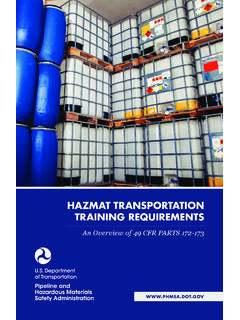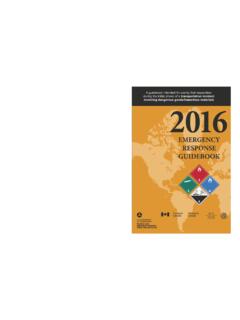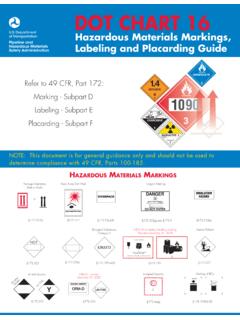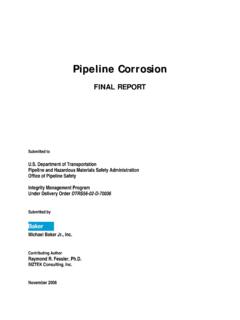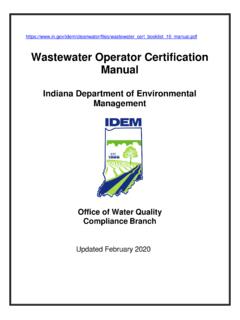Transcription of Guidance Manual for Operators of Small Natural Gas …
1 Guidance ManualforOperators of SmallNatural Gas SystemsUS Department of TransportationPipeline and Hazardous Materials Safety Administration Office of Pipeline SafetyJanuary 2017 Revised January, 2017 TO THE READER The Department of Transportation s (DOT) Pipeline and Hazardous Materials Safety Administration (PHMSA) promotes the safe transportation of Natural gas by pipeline. This Guidance Manual for Operators of Small Natural gas systems is part of our commitment to pipeline safety. This Manual was developed to provide an overview of pipeline compliance responsibilities under the federal pipeline safety regulations. It is designed for the non-technically trained person who operates a master meter system, a Small municipal system, or Small independent system. The Federal Government recognizes that many of the safety regulations are written in technical language that addresses generic requirements for both large and Small Natural gas systems.
2 This Manual attempts to simplify the technical language of the regulations. For certain critical regulations, this Manual provides details of methods of operation and selection of materials that will satisfy the pipeline safety regulations. However, this is often only one of several allowable options. This Manual provides a set of examples that Operators of Small Natural gas systems can use to meet the minimum requirements of the pipeline safety regulations. For example, requirements for pressure testing vary throughout the pipeline safety regulations. The test pressure used in this Manual is usually 100 pounds per square inch to provide clarity and consistency to Small Operators unfamiliar with the intricacies of Natural gas pipeline operations. The operator is referred to 49 CFR Part 192 for additional details and other options for reaching and maintaining compliance. Our aim is to provide basic information to Operators of Small Natural gas distribution and master meter systems to ensure compliance with the federal gas pipeline safety regulations.
3 It is hoped that this document will assist Operators in achieving and maintaining a safe and efficient Natural gas system. The result will enhance public safety the essential goal of the Office of Pipeline Safety. Alan K. Mayberry Associate Administrator for Pipeline Safety Revised January, 2017 ACKNOWLEDGEMENTS This Guidance Manual was revised by the APGA Security and Integrity Foundation (SIF) under a cooperative agreement with the DOT. The Manual relies on sources representing the best opinion on the subject at the time of publication. It should not, however, be assumed that all acceptable safety measures and procedures are mentioned in this Manual . The reader is referred to the Code of Federal Regulations (49 CFR Parts 190-199 and Part 40) for the complete pipeline safety requirements. PHMSA gratefully acknowledges the contributions of the many individuals and organizations who contributed their time and expertise to this Manual .
4 Most especially, it is a product of close cooperation with the National Association of Pipeline Safety Representatives (NAPSR). The advisory group involved in the revision of this Manual included: John Erickson, APGA SIF, Project Manager Glynn Blanton, Pipeline and Hazardous Materials Safety Administration (PHMSA) David E. Bull, ViaData Bill DeFoor, Municipal Gas Authority of Georgia William Donley, Payne Environmental Services David Hraha, Iowa Association of Municipal Utilities Chet Kokoszka, New Hampshire Public Utilities Commission Don Ledversis, Rhode Island Public Utilities Commission Gerry Lee, APGA SIF L Lognion, Heath Consultants Joe Molloy, Colorado Department of Regulatory Agencies Roy Montemarano, Heath Consultants G. C. Morris, Vermont Department of Public Service Jerry Palo, California Public Utilities Commission Rod Parcel, Iowa Association of Municipal Utilities Rudy Parcel, Iowa Association of Municipal Utilities Judy Ramsey, Alabama Public Service Commission Terry Roach, Carrollton Utilities, KY Mike Sasser, Defuniak Springs Natural Gas, FL Phil Sher, Phil Sher Associates Matt Smith, Illinois Commerce Commission Michael Smith, New Mexico Public Regulation Commission Nathan Solem, South Dakota Public Utilities Commission Larry Sorensen, Iowa Utilities Board Kevin Speicher, New York Department of Public Service Kan Wai Tong, California Public Utilities Commission Revised January, 2017 The revision and publication of this Manual is an example of constructive partnership among government, the pipeline industry and industry and professional organizations.
5 Sponsor Approval: Alan K. Mayberry PHMSA Associate Administrator for Pipeline Safety This document may be reprinted without permission from PHMSA. Any comments, suggestions or revisions should be sent to the Director, PHMSA Inspector Training & Qualifications, (PHP-70) 3700 S. MacArthur Boulevard, Suite B, Oklahoma City, OK 73179. Revised January, 2017 TOC-1 Guidance Manual FOR Operators OF Small Natural GAS SYSTEMS TABLE OF CONTENTS To The Reader Acknowledgements CHAPTER I: INTRODUCTION AND OVERVIEW Introduction I-1 Overview I-2 CHAPTER II: REGULATORS AND RELIEF DEVICES BASIC CONCEPTS II-1 Pressure II-1 Pressure and Force II-4 Flow and Throttling II-5 PRESSURE REGULATION II-5 SOME BASIC NAMES AND TERMS II-8
6 OVERPRESSURE PROTECTION II-11 Pressure Relief II-13 Monitor Regulating II-14 Automatic Shutoff II-16 INSPECTION AND TESTING OF REGULATING AND RELIEF DEVICES II-18 CHAPTER III: CORROSION CONTROL FEDERAL REQUIREMENTS III-1 Procedures and Qualifications III-1 Techniques for Compliance III-1 Corrosion Control Requirements for Pipelines Installed After July 31, 1971 III-2 Corrosion Control Requirements for Pipelines Installed Before August 1.
7 1971 III-2 Coating Requirements III-3 Examination of Exposed Pipe III-3 Criteria for Cathodic Protection III-4 Monitoring III-4 Electrical Isolation III-4 Test Points III-4 Internal Corrosion Inspection III-5 Atmospheric Corrosion III-5 Remedial Measures III-5 Graphitization of Cast Iron III-5 Records III-5 Revised January, 2017 TOC-2 FUNDAMENTALS OF CORROSION III-6 PRINCIPLES AND PRACTICES OF CATHODIC PROTECTION III-7 Types of Cathodic Protection III-14 Criteria for Cathodic Protection III-18 Coatings III-19 COMMON CAUSES OF CORROSION IN GAS PIPING SYSTEMS III-21 CHAPTER IV.
8 LEAK DETECTION AND ODORIZATION LEAK DETECTION IV-1 Methods Of Detecting A Leak IV-2 Description Of Leak Detection Equipment IV-4 RECOMMENDED METHOD FOR SURFACE GAS DETECTION SURVEY IV-9 Records IV-10 Follow-Up Inspection IV-10 ODORIZATION IV-11 Types Of Odorants IV-11 Monitoring Techniques IV-11 Odorization Equipment IV-13 CHAPTER V: UNACCOUNTED FOR GAS Unmetered Gas V-1 Gas Measurement Issues V-2 Significance of UAF V-4 CHAPTER VI.
9 REPAIRS AND NEW CONSTRUCTION Planning Ahead VI-1 Excavation VI-2 Emergency Excavation VI-2 Precautions to Avoid Damage VI-2 Reporting Damage VI-3 Mandatory Participation in One-Call Centers VI-3 PIPE INSTALLATION, REPAIR, AND REPLACEMENT VI-3 Metallic Pipe Installation VI-4 Plastic Pipe Installation VI-5 Repair Methods.
10 Plastic and Metal VI-19 MATERIALS AND EQUIPMENT FOR USE IN Natural GAS SYSTEMS VI-22 Pipe VI-22 Valves VI-25 Flanges and Flange Accessories VI-25 Regulators and Overpressure Protection Equipment VI-25 WELDING REQUIREMENTS VI-27 COMMON CONSTRUCTION PRACTICES VI-31 Plastic Pipe installation concerns Brittle like Fractures VI-42 Revised January, 2017 TOC-3 CHAPTER VII: SERVICE LINES, CUSTOMER METERS AND REGULATOR SETS Customer Meters and Regulators: Location VII-1 Customer Meters and Regulators: Protection from Damage VII-3 Customer Meters Installations: Operating Pressure VII-3 Service Lines.




